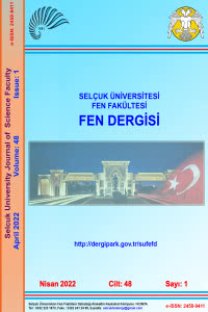EFFECTS OF THE GRADATION MAPS OBTAINED BY TWO DIFFERENT METHODS ON THE LAND CONSOLIDATION PROJECTS IN TURKEYS
Türkiye’de İki Farklı Yöntemle Elde Edilmiş Derecelendirme Haritalarının Arazi Toplulaştırma Projelerine Etkisi
___
Bayrakcı, A. G., Koçar, G., 2012, “Utilization of Renewable Energies in Turkey's Agriculture”, Renewable and Sustainable Energy Reviews, Vol. 16(1), pp. 618–633.Blaikie, P. M., Sadeque, A. Z., 2000, “Policy in the High Himalayas: Environment and Development in the Himalayan Region”, ICIMOD, Kathmandu.
Cay, T., Uyan, M., 2013, “Evaluation of Reallocation Criteria in Land Consolidation Studies Using the Analytic Hierarchy Process (AHP)”, Land Use Policy, Vol. 30, pp. 541-548.
Cay T., Ayten T., Iscan F., 2010, “Effects of Different Land Reallocation Models on the Success of Land Consolidation Projects: Social and Economic Approaches”, Land Use Policy, Vol. 27(2), pp. 262– 269.
Chartin, C., Evrard, O., Salvador-Blanes, S., Hinschberger, F., Van Oost, K., Lefevre, I., Daroussin, J., Macaire, J. J., 2013, “Quantifying and Modelling the Impact of Land Consolidation and Field Borders on Soil Redistribution in Agricultural Landscapes (1954-2009)”, Catena, Vol. 110, pp. 184-195.
Coelho, J. C., Portela, J., Pinto, P. A., 1996, “A Social Approach to Land Consolidation Schemes - A Portuguese Case Study: The Valenca Project”, Land Use Policy, Vol. 13(2), pp. 129-147.
Crecente, R., Alvarez, C., Fra, U., 2002, “Economic, Social and Environmental Impact of Land Consolidation in Galicia”, Land Use Policy, Vol. 19(2), pp. 135-147.
Demetriou, D., Stillwell, J., See, L., 2012, “Land Consolidation in Cyprus: Why is an Integrated Planning and Decision Support System Required?”, Land Use Policy, Vol. 29(1), pp. 131–142.
Demir, H., Gür, M., Cagdas, V., 2002, “Land Consolidation, Valuation and Cadastre”, FIG XXII International Congress, Washington, USA, 19-26 April 2002.
Derlich, F., 2002 “Land Consolidation: A Key for Sustainable Development – French Experience”, FIG XXII International Congress, Washington, USA, 19-26 April 2002.
Gonzalez, X. P., Alvarez, C. J., Crecente, R., 2004, “Evaluation of Land Distributions with Joint Regard to Plot Size and Shape”, Agricultural Systems, Vol. 82, pp. 31-43.
Ivkovic, M., Barkovic, D., Bacani, S., 2010, “Land Consolidation and Rural Development”, Geodetski List, Vol. 64(4), pp. 297-312.
Kirmikil, M., Arici, I., 2013, “The Role of Land Consolidation in the Development of Rural Areas in Irrigation Areas”, Journal of Food Agriculture & Environment, Vol. 11(2), pp. 1150-1155.
Kizilsu, G., 2002, “Land Consolidation in Rural Areas with Lacis” International Symposium on GIS, Istanbul-Turkey, 23-26 September 2002.
Lerman, Z., Cimpoies, D., 2006, “Land Consolidation as a Factor for Rural Development in Moldova”, Europe-Asia Studies, Vol. 58 (3), pp. 439-455.
Liu, Y. S., Yang, R., Li, Y. H., 2013, “Potential of Land Consolidation of Hollowed Villages under Different Urbanization Scenarios in China”, Journal of Geographical Sciences, Vol. 23(3), pp. 503- 512.
Martinez, R., Solla, M., Arias, P., Armesto, J., 2013, “Semi-automatic Land Consolidation Software based on Geographic Information Systems”, Computers and Electronics in Agriculture, Vol. 97, pp. 1-5.
Mihara, M., 1996, “Effects of Agricultural Land Consolidation on Erosion Processes in Semi- Mountainous Paddy Fields of Japan”, Journal of Agricultural Engineering Research, Vol. 64 (3), pp. 237-247.
Niroula, G. S., Thapa, G. B., 2007, “Impact of Land Fragmentation on Input Use, Crop Yield and Production Efficiency in the Mountains of Nepal”, Land Degradation and Development, Vol. 18, pp. 237-248.
Niroula, G. S., Thapa G. B., 2005, “Impacts and Causes of Land Fragmentation, and Lessons Learned from Land Consolidation in South Asia”, Land Use Policy, Vol. 22(4), pp. 358–372.
Pasakarnis, G., Maliene, V., 2010, “Towards Sustainable Rural Development in Central and Eastern Europe: Applying Land Consolidation”, Land Use Policy, Vol. 27, pp. 545-549.
Prazan, J., Dumbrovsky, M., 2011, “Soil Conservation Policies: Conditions for Their Effectiveness in the Czech Republic”, Land Degradation & Development, Vol. 22 (1), pp. 124-133.
Quadflieg, F., 1997, “An Economist’s View of the Measures Introduced to Accompany the Change in the Agrarian Structure”, Berichte Uber Landwirtschaft, Vol. 75, pp. 501-514.
Sklenicka, P., Hladik, J., Strelecek, F., Kottova, B., Lososova, J., Cihal, L., Salek, M., 2009, “Historical, Environmental and Socio-Economic Driving Forces on Land Ownership Fragmentation, the Land Consolidation Effect and the Project Costs”, Agricultural Economics-Zemedelska Ekonomika, Vol. 55(12), pp. 571-582.
Sklenicka, P., 2006, “Applying Evaluation Criteria for the Land Consolidation Effect to Three Contrasting Study Areas in the Czech Republic”, Land Use Policy, Vol. 23, Issue 4, pp. 502-510.
TUIK, 2008, “Tarım İstatistikleri-Sorularla Resmi İstatistikler Dizisi” 5. TÜİK Matbaası, Ankara.
Uhling, J., 1989, “Land Consolidation Agriculture and Environmental Protection”, Berichte Uber Landwirtschaft, Vol. 67, pp. 426-456.
Van Huylenbroeck, G., Coelho, J., Pinto, P.A., 1996, “Evaluation of Land Consolidation Projects (LLCs): a Multidisciplinary Approach”, Journal of Rural Studies, Vol. 12 (3), pp. 297–310.
Ulger, N. E., Cay, T., 2012, “An Assessment about Land Consolidation in Turkey”, FIG Working Week, Rome, Italy.
Yang, Z.S., Yang, L. F., Zhang, B. S., 2010, “Soil Erosion and Its Basic Characteristics at Karst Rockydesertified Land Consolidation Area: A Case Study at Muzhe Village of Xichou County in Southeast Yunnan, China”, Journal of Mountain Science, Vol. 7 (1), pp. 55-72.
Zhang, Z. F., Zhao, W., 2013, “A Parametric Approach to Assess the Sustainability of Land Consolidation: A Case Study in Shandong Province, North China”, Agroecology and Sustainable Food Systems, Vol. 37(4), pp. 444-464.
- ISSN: 2147-9364
- Yayın Aralığı: 2
- Başlangıç: 2013
- Yayıncı: Selçuk Üniversitesi Mühendislik Fakültesi
METİLEN MAVİSİNİN MAGNETİK NiFe2O4/AKTİF KARBON NANOKOMPOZİTİ İLE ADSORPSİYONU: KİNETİK VE İZOTERM
AYHAN ABDULLAH CEYHAN, ORHAN BAYTAR
PENCERE BOŞLUKLU PERDE DUVARLA GÜÇLENDİRİLMİŞ 1/3 ÖLÇEKLİ BETONARME ÇERÇEVELERİN DAVRANIŞI
FATİH SÜLEYMAN BALIK, FATİH BAHADIR, MEHMET KAMANLI, HASAN HÜSNÜ KORKMAZ, ALPTUĞ ÜNAL, M. Yaşar KALTAKCI
FPGA TABANLI DİJİTAL HABERLEŞME SİSTEMLERİNİN SYSTEM GENERATOR ARACI İLE ANALİZİ
İBRAHİM IŞIK, MEHMET EMİN TAĞLUK
ÖZLEM SALLI BİDECİ, Kader MERCANOĞLU, ALPER BİDECİ
MEGA ŞEHİR İSTANBUL'UN FIRTINALARININ ARAŞTIRILMASI
Emrah Tuncay ÖZDEMİR, Emrah Tuncay ÖZDEMİR
MUZAFFER KANAAN, RÜŞTÜ AKAY, MEMDUH SUVEREN
FAST K-MEANS COLOR IMAGE CLUSTERING WITH NORMALIZED DISTANCE VALUES
